
Wireless charging through the air for our phones and tablets may be possible in the future after a team of researchers created a groundbreaking technique for transmitting energy.
As reported first by ScienceAlert, researchers have successfully transmitted 400mW of infrared laser light at a 30-meter distance (98 feet). Small sensors can be charged with that amount of power, but in the future, they might also be developed to power larger devices such as smartphones.
All of this is accomplished completely securely since the laser automatically switches to a low-power mode when it is not used.
Distributed Laser Charging
The specific type produced here manages to be safer and can travel further than prior trials with wireless power transmission technology. The technical name for it is distributed laser charging.
"While most other approaches require the receiving device to be in a special charging cradle or to be stationary, distributed laser charging enables self-alignment without tracking processes as long as the transmitter and receiver are in the line of sight of each other," electrical engineer Jinyong Ha, from Sejong University in South Korea, said in a statement.
A laser cavity's light-bouncing parts would be typically housed in a single device. As they are divided into a transmitter and a receiver in this instance, the laser cavity forms in the area between them as long as the transmitter and receiver are in the line of sight, according to ScienceAlert.
The experimental setup involved placing an amplifier transmitter 30 meters from the receiver, equipped with a photovoltaic cell, to turn the light signal into electrical power. The transmitter was specially coated with metal erbium for the experiment.
This receiver is small enough to fit into small devices like sensors, measuring only 10 millimeters by 10 millimeters (0.4 inches by 0.4 inches). In this approach, smaller smart home gadgets like temperature or motion sensors might be wirelessly charged.
The laser's safest region of the infrared spectrum has a core wavelength of 1550 nanometers, which cannot harm the skin or eyes of people. To increase system efficiency and ensure that the most energy was transported, the scientists made a number of additional adjustments.
Although the technology is still in its infancy, wireless energy transfer may prove helpful for personal electronics and industrial settings where cabling is difficult to install or maintain.
This article is owned by Tech Times
Written by Joaquin Victor Tacla
![Apple Watch Series 10 [GPS 42mm]](https://d.techtimes.com/en/full/453899/apple-watch-series-10-gps-42mm.jpg?w=184&h=103&f=9fb3c2ea2db928c663d1d2eadbcb3e52)



